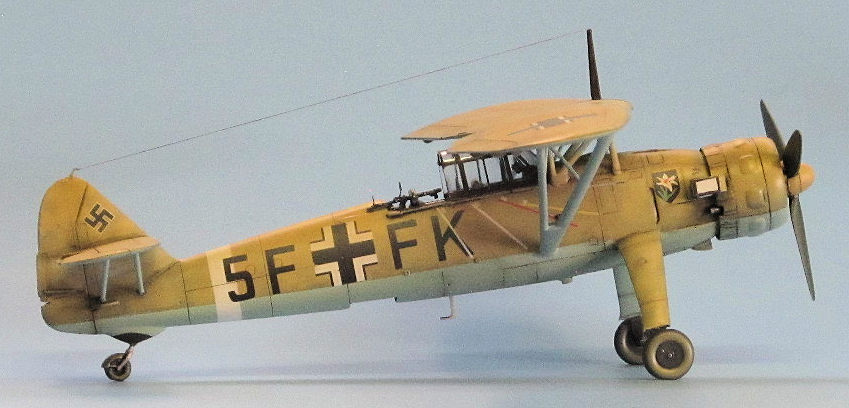
KP 1/72 Hs-126A/B-1
| KIT #: | KPM 0337 |
| PRICE: | $25.00 |
| DECALS: | Three options |
| REVIEWER: | Ryan Grosswiler |
| NOTES: | Reboxed Sabrekits tooling |

| HISTORY |
From the very beginning of the military airplane, army generals who had any forward-thinking tendencies immediately saw the value of the new invention as putting (1) a set of eyes up in the sky for observational purposes, and (2) speeding up communication between far-flung ground units. Most armies accordingly developed a class of aircraft to meet this need. Over the two decades which followed the Great War, this class of aircraft continued development, seeing final form around the world in such types as the Polikarpov R-5, Douglas O-46, and the Westland Lysander.
The big Henschel had a strangely convoluted development period for such a seemingly simple aircraft, taking almost four years from the abortive Hs-122 prototype to the finalized Hs-126's service entry as decisions regarding airframe proportion and powerplant were haggled over. The type which finally emerged was quite capable in short field performance, with some substantial offensive combat capability in the form of a forward gun and optional bomb rack clipped oddly to the left wing strut root, and a camera bay further aft which could also house a cannister of light bombs. Just like its foreign contemporaries, however, the type was a strangely large and powerful aircraft for being a low performance two-seater. A 20% increase of internal fuselage volume at the center of gravity would have made it (like the others) so much more versatile.
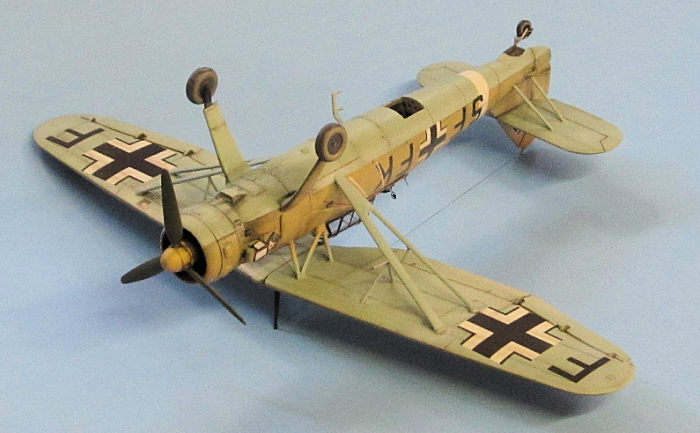 The
type did well in Spain, where it arrived in time for the final actions there.
Production gained
tempo after that, and by September 1939 a few hundred were in service with the
Luftwaffe. While the service pretty much had its way in the first year of the
war and the type not only performed its design observation and cooperation role,
but also directly as a combat aircraft, heavy losses in France at once devalued
the Henschel's tactical concept, and production was tapered off with equal speed
by the end of 1940. The type rapidly disappeared altogether from the front lines
after the first year of the invasion of the Soviet Union, its role being split
between the Fw-189 and more practical Fi-156 Storch. A
Staffel
was sent to assist Rommel in North
Africa, where the Allies prized them when captured as light transports.
The
type did well in Spain, where it arrived in time for the final actions there.
Production gained
tempo after that, and by September 1939 a few hundred were in service with the
Luftwaffe. While the service pretty much had its way in the first year of the
war and the type not only performed its design observation and cooperation role,
but also directly as a combat aircraft, heavy losses in France at once devalued
the Henschel's tactical concept, and production was tapered off with equal speed
by the end of 1940. The type rapidly disappeared altogether from the front lines
after the first year of the invasion of the Soviet Union, its role being split
between the Fw-189 and more practical Fi-156 Storch. A
Staffel
was sent to assist Rommel in North
Africa, where the Allies prized them when captured as light transports.
The Greeks also liked the Henschel and ordered 16, adding another gun firing forward and expanding the bomb capacity with permanent racks beneath the cockpit. When the Italians dorked their way into the country in 1941 and got clobbered by the outnumbered, underequipped, but professionally capable Greeks, the Henschels were part of the defence. On one occasion, three Greek 126s attacked and strafed a four-mile Italian column on the Pogradec road, in the course of twenty minutes absolutely scattering the formation. The Germans intervened to save their foundering ally, setting up the situation where Hs-126 flew against Hs-126.
The type didn't really otherwise distinguish itself in combat, and given its yeoman role, was never really destined to do so. Except this: one September morning in 1943 ten of these planes struggled over the Italian Alps, each hauling a single DFS 230 glider full of Germany's most elite paratroopers. This formation of gliders was released, descending on to a high Alpine meadow to the ski resort where Benito Mussolini was being held captive by the transitional Italian government. The attack was such a surprise that the deposed dictator was whisked away no more than ten minutes later by an overloaded Storch which itself nearly dashed to pieces on the rocks below after a sketchy takeoff.
There aren't any surviving examples aside from some 'substantial remains' held by a museum in Germany. The Army Cooperation role was taken over by all militaries after the war by the helicopter.
| THE KIT |
For a very long time, long after scale model manufacturers had been scraping the bottom of the barrel for new Luftwaffe subjects both obscure and imaginary, all we had for the Hs-126 were the 40-year-old Matchbox, Airfix, and Italerei kits. I have built the latter two, and these weren't bad by any means, but are products of their era with raised and rather coarse detailing. I think the Italerei model sits too high on its gear.
Suddenly, both Brengun and a relative unknown called Sabrekits from the same region came out with two different kits at about the same time. Being a prolific aftermarket supplier, Brengun also released sets covering internal and external details and some nicely-rendered armament, including a smoke dispenser for the stores rack. Supposedly it's a little underscale, but I have not seen the kit up close. Sabrekits followed immediately after with their totally separate product.
I
don't know what the relationship is, but soon this kit was passed along to be
marketed in a KP box. Kovozavody Prostejov (or simply "KP") is a name familiar
to those of us who remember during the Cold War the alluring mystery of these
kits sometimes issuing under special circumstances from behind the Iron Curtai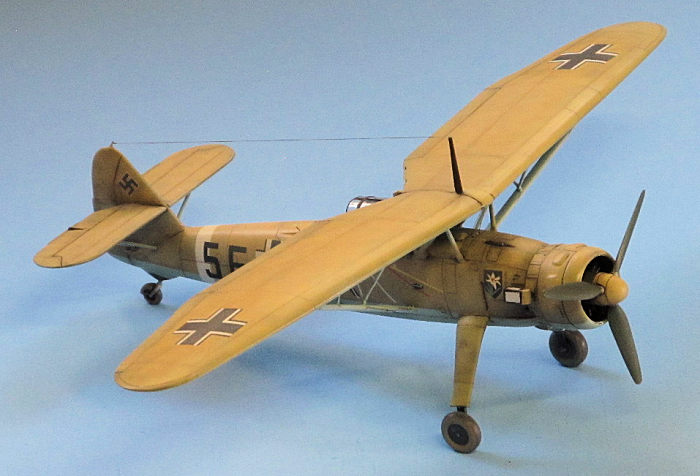 n,
but the firm who released the kit here has little to do with the entity we
wondered about during the years of Able Archer '83, The Day After, and "Mr.
Gorbachev, tear down that wall!" With the fall of the East Bloc, the
no-copyright name was up for grabs and supposedly acquired by AZ Models. But not
KP's old molds, which are now marketed under the Smer and Mistercraft labels.
Throw in the fact old Heller kits are marketed from time to time under these
names too and it becomes clear that there's a '70s Southern California-style
kit-swapping orgy going on. We just need to throw in some Jose Cuervo, quaaludes,
and pipe in the Steely Dan.
n,
but the firm who released the kit here has little to do with the entity we
wondered about during the years of Able Archer '83, The Day After, and "Mr.
Gorbachev, tear down that wall!" With the fall of the East Bloc, the
no-copyright name was up for grabs and supposedly acquired by AZ Models. But not
KP's old molds, which are now marketed under the Smer and Mistercraft labels.
Throw in the fact old Heller kits are marketed from time to time under these
names too and it becomes clear that there's a '70s Southern California-style
kit-swapping orgy going on. We just need to throw in some Jose Cuervo, quaaludes,
and pipe in the Steely Dan.
So, whatever. Pick up this attractive but flimsy end-opening box to spill out the contents and you are greeted with high end limited-run fare, no multimedia. Canopy is injected, single piece. Two sprues with fine raised and recessed detail as appropriate carry the parts. A big, beautiful decal sheet with 3 marking options plus stencils; one for the stunning box art subject, another for a captured example in Australian hands in the same theatre, the third in service with Franco's air force in the '50s. There was an engine change between Hs-126A and B; but only one is included and it looks to me more like the BMW 132 appropriate to the 'A'. Still, the Bramo Fafnir which followed was also 9-cylinder radial, and there's a spinner fairing to obscure the crankcase, so once buried inside the cowl and painted up it'll be indistinguishable either way. There's a complete group of instrument panel, side consoles, and radio faces offered by Yahu Models as a color photoetched set—I highly recommend this aftermarket upgrade as these items are only represented in the kit by decals and spare raised detail. That cockpit's going to be very visible under the partially open canopy.
| CONSTRUCTION |
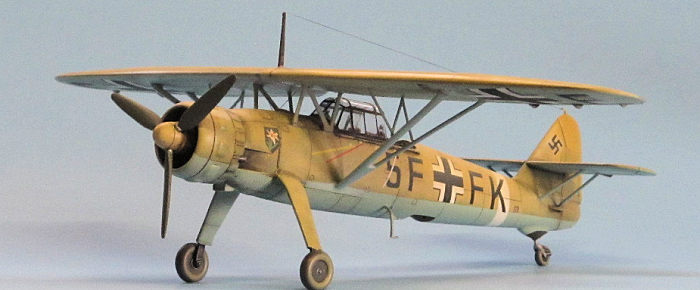 Kit prep: I started by lightly
sanding the fuselage mating surfaces, then ensuring that the transparent canopy
part fit to them assembled without further sanding or shimming.
This is done owing to painful
experience with other limited-run kits. If there are problems with the
canopy-to-fuselage fit, trust me, you want to deal with them now! The canopy
fits just fine, however. It does have a little optical distortion around the
top, which shouldn't bother most folks since it's mostly hidden under that
parasol wing, but there's an outfit called
MH Models out
of the Czech republic which offers a vac-form replacement—this also fits just
fine. I also sanded down the wing halves on their mating surfaces fairly
aggressively to get a sharper trailing edge.
Kit prep: I started by lightly
sanding the fuselage mating surfaces, then ensuring that the transparent canopy
part fit to them assembled without further sanding or shimming.
This is done owing to painful
experience with other limited-run kits. If there are problems with the
canopy-to-fuselage fit, trust me, you want to deal with them now! The canopy
fits just fine, however. It does have a little optical distortion around the
top, which shouldn't bother most folks since it's mostly hidden under that
parasol wing, but there's an outfit called
MH Models out
of the Czech republic which offers a vac-form replacement—this also fits just
fine. I also sanded down the wing halves on their mating surfaces fairly
aggressively to get a sharper trailing edge.
Interior: here I deviated from the instructions slightly by fitting and cementing the main bulkheads (parts 9, 10, and 11) and floor parts (13 and 14) into the left fuselage half before any further work. This was to ensure that any coarse cutting and grinding of these parts was complete before any delicate cockpit detailing and painting got underway. The instructions would have you put together and paint the cockpit as an independent assembly before installation.
I remarked above that the interior will be really visible on the completed model and thoughtful time and effort spent here will not go to waste. A few scratchbuilt bits and some parts from an old Eduard photoetch set (dated 1993...so old that it carries serial number 72-108, claims to be from "Czechia", and Eduard has no record of it on their otherwise comprehensive site) aimed at the Italerei kit rounded out the interior. This was mostly because I had it on hand, though it's a bit undersize. What the kit provides is mostly adequate, but I felt it could do with some embellishment. Especially since I chose to open up the peculiar bomb/camera bay aft of the cockpit and more light was therefore spilling into the void.
This was followed with careful painting and highlighting. Before this work was closed up in the fuselage halves, the decal seatbelts were applied to varnished lead wine foil, carefully sliced free, and glued in natural post-flight poses on their respective seats. I replaced the observer's MG-15 with the even better one left over from ICM's Fw-189, using the dozen spare magazines from the same source to fill up a scratch-built rack. Because I couldn't find detailed information for the camera mounting or small bomb cartridges carried back there (and it probably wouldn't have used those features by this stage in the war) I simply left the bay empty.
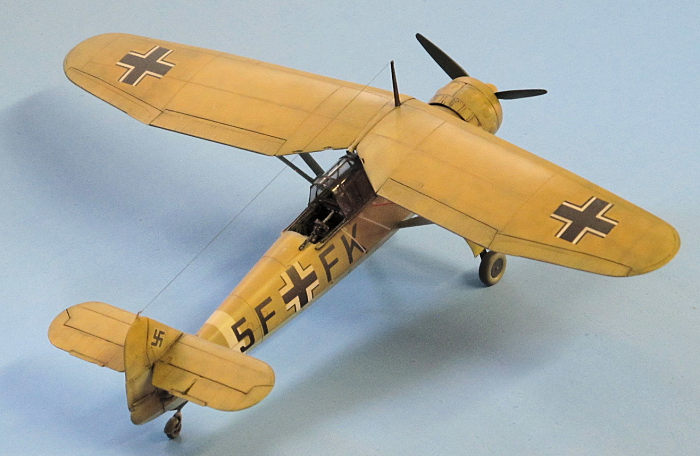 The engine/cowl/propeller group
was built up and painted alongside. The propeller assembly can be made into a
neat press-fit with the crankcase fairing (Parts 40) if assembled carefully. The
landing light part sprang forth out of my tweezers and was lost in the void, so
was replaced with a little square of clear plastic and an MV products lens.
Looks better, anyway! On a related note, I cut open the first aid kit access at
the rear of the left fuselage, installed a tiny clear window, and then applied
the Red Cross decal backwards to face outside through the plastic. It's a tiny
detail, but it looks really cool.
The engine/cowl/propeller group
was built up and painted alongside. The propeller assembly can be made into a
neat press-fit with the crankcase fairing (Parts 40) if assembled carefully. The
landing light part sprang forth out of my tweezers and was lost in the void, so
was replaced with a little square of clear plastic and an MV products lens.
Looks better, anyway! On a related note, I cut open the first aid kit access at
the rear of the left fuselage, installed a tiny clear window, and then applied
the Red Cross decal backwards to face outside through the plastic. It's a tiny
detail, but it looks really cool.
Odd tail angle: Nice as it is, the one thing the kit missed was the type's characteristic 2o LH vertical stabilizer incidence to counteract left-turning tendencies. Because the stabilizers were mounted to this angled fin, the entire tail group sat cockeyed like this. It's quite visible in photographs of the real aircraft taken from above. The fin was therefore cut back at the root to the rudder hinge line, bent and glued in place at the appropriate angle, then filled and sanded to restore the contour. An important modification, and the process only waylaid me about fifteen minutes.
I found myself wanting to spend a lot of time adding lots of little extras. The 126 was a very 'busy' airframe, and time spent studying photographs of the airplane, inside and out, then following up to embellish the kit's already good level of detail is well spent.
I glued only the cabane struts (parts 33) at this time. After they had set up for twenty minutes or so I checked their alignment against their marked locations on the lower wing, and left them to cure for 24 hours. Having learned a painful lesson about painting parasol-winged aircraft after assembly with my Academy PBY-5 Catalina, the mainplane was left off through the finishing process with the strut mounts masked off and the struts themselves cleaned up. I was sorely tempted to fit that odd bomb rack contraption to the wing strut, but none of my sources indicated that this was present after the Polish campaign.
| COLORS & MARKINGS |
Basic colors were sprayed with MRP/Mr. Paint colors. The topsides of Hs-126s deployed with the Afrika Korps had the RLM 79 Sandgelb sprayed over the standard early-war 65/70/71 finish, and photographs clearly reveal that the style varied greatly according to the preferences and aptitude of the sprayer. I found two photos of 5F+FK in the field, and they showed a barely-discernable light mottle under some severely bleached Sandgelb, probably just a bare trace of the original green splinter scheme showing through. I simply painted the RLM 79 and 65 as base coats, sprayed a little Dunkelgrun mottle over the upper surfaces, and buried that under more Sandgelb until it was barely showing, like the photos.
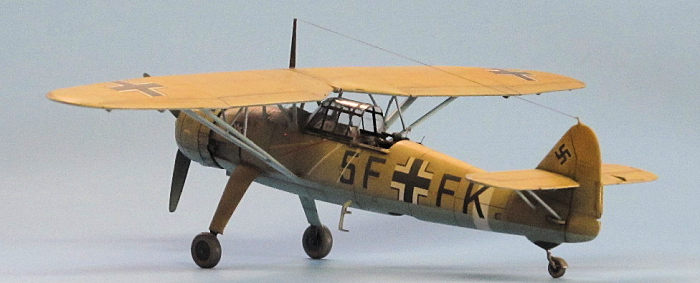 This finish was protected with
a coat of Gunze gloss clear and the excellent decals went on over this,
responding well to both Micro Set and Sol. The photos showed that the markings
were also noticeably faded, so one more very thin 'filter' coat of greatly
lightened MRP Sandgelb then went over everything, which not only achieved the
desired effect but also pulled the whole scheme together nicely. A couple more
barrier coats of Gunze clear went over this; wash
and highlighting followed.
This finish was protected with
a coat of Gunze gloss clear and the excellent decals went on over this,
responding well to both Micro Set and Sol. The photos showed that the markings
were also noticeably faded, so one more very thin 'filter' coat of greatly
lightened MRP Sandgelb then went over everything, which not only achieved the
desired effect but also pulled the whole scheme together nicely. A couple more
barrier coats of Gunze clear went over this; wash
and highlighting followed.
Painting and weathering generally complete, the wing was now carefully glued to the cabane struts, poked and prodded into alignment, 'jigged' with a couple of paint bottles, then left to cure fully overnight. This rather fragile assembly was secured the following morning when the main struts were glued in. The ancillary struts then followed (Parts 52, and a very dicey procedure), then the tail struts. These joints were lightly sanded where necessary and touched up with dabs of RLM 65, an EZ Line antenna went into place, and she was done.
| CONCLUSIONS |
KP/Sabrekit's product nails the Hs-126's perky, tippy-toe look quite well, and by limited-run standards fit is excellent throughout. If it weren't for the inherent difficulties of the parasol-wing layout I'd have no trouble recommending this kit to anyone with a few builds under his belt. As such, it absolutely blows everything that came before it out of the water. A great kit of one of the last of the "army cooperation" breed to see service. Get the Yahu panel detail set to dress up that open interior. This was such a pleasant build that I'm now looking into other kits from this source.
| REFERENCES |
Panek and Peczkowski, Henschel Hs-126. Mushroom Model Publications, Redbourn, UK. 2005. ISBN #978-83-89450-40-1
Gunston, Bill. Classic Aircraft Cutaways. Osprey Publishing, London. 1995. ISBN# 1-855325268
Green, William. Warplanes of the Third Reich. Gallahad Books, New York. 1970. ISBN# 0-88365-666-3
16 February 2024
Copyright ModelingMadness.com. All rights reserved.
No reproduction in part or in whole without express permission. If you would like your product reviewed fairly and fairly quickly, please
contact
the editor
or see other details in the
Note to
Contributors.